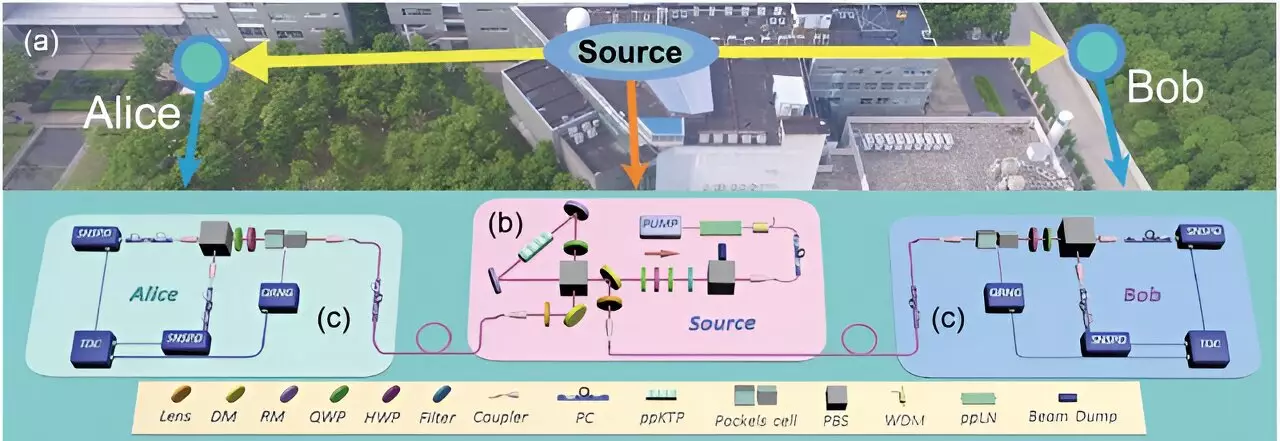In a monumental leap for quantum mechanics, a dedicated research team has executed a groundbreaking, loophole-free test of Hardy’s paradox—an achievement that affirms the complexities of quantum nonlocality and challenges the traditional ideas underpinning local realism. The study was led by prominent figures such as Prof. Pan Jianwei and his colleagues from the University of Science and Technology of China (USTC), in partnership with experts from Nankai University. Their findings, which profoundly alter our comprehension of quantum mechanics, have been featured in an “Editor’s Suggestion” article in Physical Review Letters.
To grasp the significance of this achievement, one must first understand Hardy’s paradox, which was introduced by physicist Lucien Hardy in the 1990s. At its core, this paradox simplifies the challenges of local realism—the classical viewpoint suggesting that physical properties persist independently of measurement, and that no influence can travel faster than light. Hardy illustrated a situation where three events, deemed “Hardy events,” hold a zero probability in a local realist framework, yet quantum mechanics predicts a non-zero probability for a fourth event under specific conditions. This contradiction lies at the heart of the tension between quantum mechanics and classical physics, and it has served as a touchstone in investigating the perplexities of quantum theory.
Experimentally validating Hardy’s paradox poses considerable challenges, primarily due to the inherent low probability associated with observing the fourth event. As such, researchers must rely on high fidelity and efficiency from their entangled photon sources to effectively isolate true events from background noise. Prior attempts at such experimental verification were hindered chiefly by two significant issues—the locality loophole and the detection efficiency loophole. The locality loophole implies that the choices made in measurement could potentially interfere with the outcomes, undermining the experiment’s validity. Concurrently, the detection efficiency loophole arises from optical losses, which can skew results.
To overcome the locality loophole, the research team devised an intricate setup ensuring spacelike separation of measurement choices from both the preparation of the entangled states and the detection of photons. This configuration eliminates the risk of causal connection between measurement settings and results, effectively nullifying the locality loophole. The researchers also prioritized the detection efficiency loophole, achieving an impressive detection efficiency of 82.2%. This advancement significantly minimizes the effects of optical losses, enhancing the robustness of their experimental findings.
To further augment the integrity of their measurements, the team integrated high-speed quantum random number generators for selecting measurement settings. This innovation ensured true randomness in the selection process, altogether shielding the study from any influences from local hidden variables. By factoring in both undetected events and double-click events through an advanced reinterpretation of Hardy’s inequality, they effectively addressed the detection efficiency loophole, culminating in an experimental architecture that robustly supports the tenets of quantum physics.
The results of the experiment were nothing short of compelling. Conducted over a grueling six-hour period, the team recorded a profound violation of Hardy’s paradox with a striking significance level approaching 5 standard deviations across a staggering 4.32 billion trials. The confirmation of a null hypothesis indicated that local realism could account for these outcomes with a probability less than 10^-16348—essentially writing off local realism as a plausible explanation for the results obtained.
The implications of this research reach far beyond academic inquiry; they signal a vital step forward in the development of quantum technologies. This includes advancements in quantum key distribution, enhanced cybersecurity protocols, and the potential for quantum random number generation. The successful closure of both loopholes presents a crucial contribution to the ongoing exploration of quantum mechanics, fostering greater comprehension of the quantum realm and its numerous possibilities.
The teamwork and ingenuity displayed in this research not only defend the tenets of quantum nonlocality but also reshape our perspective on the fundamental nature of reality as described by physics. As we advance further into the age of quantum technology, this study lays foundational groundwork for future explorations, opening doors to innovations once believed to be the realm of science fiction. This work serves as a powerful reminder of the intricacies of quantum dynamics and the relentless pursuit of knowledge that pushes the boundaries of our understanding.


Leave a Reply